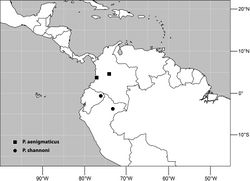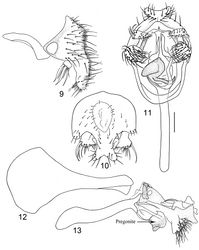Planinasus aenigmaticus
| Notice: | This page is derived from the original publication listed below, whose author(s) should always be credited. Further contributors may edit and improve the content of this page and, consequently, need to be credited as well (see page history). Any assessment of factual correctness requires a careful review of the original article as well as of subsequent contributions.
If you are uncertain whether your planned contribution is correct or not, we suggest that you use the associated discussion page instead of editing the page directly. This page should be cited as follows (rationale):
Citation formats to copy and paste
BibTeX: @article{Mathis2012ZooKeys225, RIS/ Endnote: TY - JOUR Wikipedia/ Citizendium: <ref name="Mathis2012ZooKeys225">{{Citation See also the citation download page at the journal. |
Ordo: Diptera
Familia: Periscelididae
Genus: Planinasus
Name
Planinasus aenigmaticus Mathis & Rung & Kotrba, 2012 sp. n. – Wikispecies link – ZooBank link – Pensoft Profile
Description
Moderately small flies, body length 2.70 mm (holotype).
Head: Frons mostly bare, shiny, except for more densely microtomentose, anterolateral angles; frons wider than long, frontal ratio 0.50–0.58; interfrontal seta moderately short, about 2/3 length of lateral vertical seta. Antenna unicolorous, blackish brown; pedicel with ventral projection short, not extended anteriorly much beyond dorsal margin; basal flagellomere short, about as long as high, mostly yellow (faintly black around base of arista); arista bearing 8–9 dorsal rays, 3–4 ventral rays. Face comparatively narrow; facial ratio 0.24–0.39; dorsal half of face shield-like, mostly bare, roughly pentagonal, with yellowish to slightly bluish reflections; large facial setae arranged in 2–3 irregular, transverse rows, dorsal row with 4 setae, 2 dorsoclinate, 2 ventroclinate; ventral facial row with 4 ventroclinate setae. Clypeus and palpus blackish brown.
Thorax: Generally dark brown but with some paler, mostly yellowish areas along margins of sclerites; mesonotum moderately invested with whitish gray microtomentum, appearing dull medially, becoming subshiny, less microtomentose laterally; postpronotum yellowish; area from postpronotum and through notopleuron mostly bare, shiny; anepisternum moderately invested with very fine microtomentum, mostly appearing dull; other pleural areas less densely invested. Wing mostly hyaline to very faintly infumate, without pattern. Coxae whitish yellow; femora whitish yellow on basal 2/3, only distal 1/3 dark brown; forefemur bearing 1–3 subequal, posteroventral setae at apical 1/3; lacking a preapical annulus; tibiae with base and apex yellow, middle 2/3 brownish black; basitarsomere yellowish, apical 3–4 tarsomeres darker; forefemur bearing 2 setae at apical 1/3 along posteroventral surface.
Abdomen: Uniformly blackish brown, mostly subshiny, moderately invested with microtomentum. Male abdomen: Tergites 1+2-6 well developed, lengths of tergites 3–6 subequal; sternite 3 only slightly wider than long, posterior margin sinuous with a medial, broad, rounded projection; width of sternite 4 over twice length, sclerotized portion moderately deeply emarginate with broad, V-shaped membranous area posteriorly; width of sternite 5 over twice length, becoming slightly wider posteriorly, posterior margin shallowly emarginate, bearing 1–2 setulae at posterolateral corners; sternite 6 apparently absent; sternite 7 narrow, forming an annulus with tergite 7. Male terminalia (Figs 1–4): Epandrium in lateral view (Fig. 1) triangular to trapezoidal, dorsal margin narrowly angulate; surstylar length slightly less than half length of epandrium, surstylus extended from ventral margin of epandrium in nearly vertical alignment with anterior margin of it , in lateral and ventral views (Figs 1–2) digitiform, apex bluntly rounded to truncate, length approximately twice width, bearing 4 strong posteromedial setulae and a few smaller setulae along posterior and apical portions; hypandrium in ventral view (Fig. 2) U-shaped with anterior portion of U with a short, trapezoidal projection; pregonite in ventral view (Fig. 2) approximately triangular, with anterior margin receded; postgonite in ventral view convoluted (Fig. 2), apex bearing narrow subrectangular projection, with robustly developed, clavate lobe bearing more than 20 setulae, in lateral view (Fig. 4) with lobe moderately expanded, broadly rounded apically, bearing numerous setulae; phallus large, in ventral and lateral views (Figs 2, 4) complex, mostly sclerotized; phallapodeme in lateral and ventral views (Figs 2, 4) elongate, tubular, truncate apically; ejaculatory apodeme in lateral view (Fig. 3) large, about 1/3 longer than length of phallapodeme , apical half greatly expanded, fan-like, basal half narrow, stem-like but slightly expanded toward base.
Type material
The holotype male is labeled “W of Bogota COLOMBIA/M R Wheeler collector/USNM ENT 00118284 [plastic bar code label]/HOLOTYPE ♂ Planinasus aenigmaticus Mathis & Rung USNM [red].” The holotype is double mounted (glued to a paper point), is in good condition (abdomen removed, dissected, stored in an attached microvial), and is deposited in the USNM. A male paratype (CAS) is as follows: COLOMBIA. Valle del Cauca: Río Raposo (03°43'N, 77°08'W), Oct 1964, V. H. Lee.
Type locality
Colombia. Bogota: Bogota (west; 04°35.8'N, 74°08.8'W).
Distribution
(Fig. 5). Neotropical: Colombia (Bogota, Valle del Cauca).
Etymology
The specific epithet, aenigmaticus, is of Greek derivation, meaning something baffling or puzzling, and refers to the puzzling nature of this species, as well as the genus.
Remarks
This species, represented by two males only, is known only from Colombia and is the only species of Planinasus known to occur in that country. It is very similar to Planinasus neotropicus and Planinasus ambiguous, and analysis of the male genitalia is generally necessary to distinguish among the three species. Characters of the male terminalia of Planinasus ambiguous are very distinct, particularly the shape of the epandrium (Fig. 10), the length and shape of the surstylus (Fig. 9), and the uniform, U-shaped hypandrium. From Planinasus neotropicus, Planinasus aenigmaticus can be easily distinguished by the surstylus, digitiform over its entire length and with about four posteromedial setulae (Fig. 1), and the U-shaped hypandrium with the anterior margin bearing a short, trapezoidal projection (Fig. 2). In Planinasus neotropicus, the surstylus is bulged basally, there is only one medial seta on it (Fig. 15), and the hypandrium is V-shaped (Fig. 16).
Original Description
- Mathis, W; Rung, A; Kotrba, M; 2012: A revision of the genus Planinasus Cresson (Diptera, Periscelididae) ZooKeys, 225: 1-83. doi
Images
|



